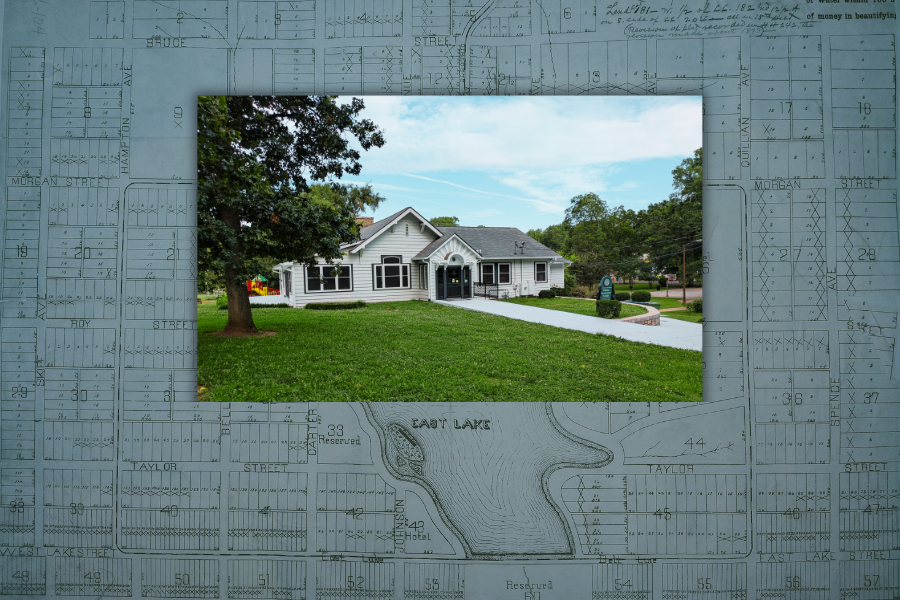The Bauhaus and The International Style in DeKalb
An Overview of Bauhaus and The International Style in DeKalb
By Michael Lehman, DHC Board Member
When planning a trip to Germany last year with another architect friend, it struck us that we should plan a day trip to the Bauhaus while we were in Berlin. The Bauhaus is an important place to every architect’s understanding of modern architecture, so a visit to “the place where it started” seemed like a good idea.
Beginning in the mid-19th century, several strains of design and architecture began to emerge to challenge the academic Neoclassicism of the traditional architectural schools, typified by the École de Beaux-Arts in Paris. William Morris, with the Arts and Crafts movement in England, and later, Art Nouveau, beginning in France and Belgium and spreading across Europe, rejected older ways of thinking about design and architecture. Groups like the Wiener Werkstatte in Vienna were formed to connect all the arts and crafts work and became more influential in changing the public perception of art and architecture. However, these movements still relied on decoration and hand craftsmanship that was increasingly at odds with industrialization and technological advances.
The Deutsche Werkbund was founded in Germany in 1907 to encourage collaboration between architecture and industry, and help to plant the seeds for a new aesthetic to develop. Members of the Deutsche Werkbund included Peter Behrens and Mies van der Rohe, and Viennese architects Otto Wagner and Josef Hoffman, who had also been members of the Wiener Werkstatte.
In 1909, Peter Behrens designed the Turbine Hall for German electrical manufacturer AEG, which broke new ground in the design of industrial buildings. Two years later, Walter Gropius and Hannes Meyer, who had worked on that project, went even further with the design of the Fagus factory in Lower Saxony, the first building to incorporate a glass “curtain wall.” Other architects, like J.J.P. Oud in Rotterdam and Swiss architects Le Corbusier and Pierre Jeanneret, were also breaking new ground. Le Corbusier’s Pavillon de l’Esprit Nouveau at the International Exhibition of Modern Decorative and Industrial Arts in 1925 was an almost scandalous success, using obviously industrial materials and no ornamentation. The Art Deco style came out of the same exhibition, and developed in parallel with the more stripped-down style of the Le Corbusier’s pavilion. Over time, Art Deco became less decorative, morphing into Streamline Moderne, which had its heyday and ultimate demise at the 1939 New York World’s Fair.
(Top L) AEG Turbine Hall by Peter Behrens Photo: Wikipedia (Top R) Fagus Factory by Walter Gropius Photo: Wikipedia.
(Bottom L) Pavillion de L’Esprit Nouveau by Le Corbusier and Pierre Jeanneret. Photo: Wikipedia. (Bottom R) Worker Housing by J.J.P. Oud Photo: Pinterest.
Influenced by these cultural currents, the Bauhaus was founded by Walter Gropius in 1919 in Weimar, Germany, then the capital of the German state of Thuringia. Weimar was the town where Germany’s post-World War I democratic constitution was signed, giving its name to the short-lived Weimar Republic. The intent of the Bauhaus was to bring together all the creative arts and crafts as part of the philosophy of Gesamtkunstwerk (Comprehensive Artwork). Study programs at the Bauhaus included architecture, industrial design, painting, textile design and graphic design. The Bauhaus even produced a dance performance, the geometry-inspired Triadic Ballet.
Other architects who worked there over time included Hannes Meyer, Marcel Breuer and Mies van der Rohe; artists like Wassily Kandinsky, Paul Klee and László Moholy-Nagy were also included. The government of Thuringia initially funded the Bauhaus, but after a few years, the state government became more conservative and cut its funding in half. The town of Dessau invited the Bauhaus to relocate, which it did in 1925. Dessau is where the iconic Bauhaus building complex was built, designed by Walter Gropius and opened in 1926.
The Bauhaus complex consists of the studio building connected to a student dormitory by a low building containing an auditorium and canteen. A bridge containing administrative offices spanned over the entry drive to connect to a vocational school building for local students (required by the Dessau city government). The most important building is the studio building. The structural columns of the building are pulled inside so that the glass curtain wall is uninterrupted. A system of chains and pulleys allows portions of the curtain wall facade to be opened for ventilation. The solid portions of the building are smooth stucco painted either white or gray, with no ornamentation.
(Top L) Bauhaus Studio by Walter Gropius. Photo: Wikipedia X Spyrosdrakopoulos (Top R) Bauhaus Complex by Walter Gropius Photo: moderne-regional.de.
(Middle L) Bauhaus Dormitory by Walter Gropius. Photo: Michael Lehman. (Middle R) Bauhaus Interior by Walter Gropius.
(Bottom L) Bauhaus Furniture. Photo: Michael Lehman. (Bottom R) Triadic Ballet Costumes. Photo: Michael Lehman.
With the rise of the Nazi party, the modernist (and socialist) ideas of the Bauhaus came under political pressure again. The Nazis considered the Bauhaus design philosophy to be “degenerate art.” In 1932, the Bauhaus relocated to Berlin under the leadership of Mies van der Rohe. It only lasted in that location for six months when it was closed by the Nazi SA in April 1933.
After the demise of the Bauhaus, there was an exodus of architectural talent from Germany. Most notably, Walter Gropius and Mies van der Rohe came to the United States. Gropius went to Harvard and eventually became the head of the architecture program; Mies went to Chicago and became the head of the architecture school at Illinois Institute of Technology. Their work in academia influenced generations of architects who were trained from the 1930s through the 1960s. Other Bauhaus trained architects immigrated to then-British Palestine, and created what came to be known as the “White City” district of Tel Aviv.
The new style of architecture that came out of the Bauhaus was dubbed the “International Style” by Philip Johnson and Henry Russell Hitchcock in their influential Modern Architecture International Exhibition at the Museum of Modern Art in New York in 1932. That same year, George Howe and William Lescaze designed the first International Style skyscraper for the Philadelphia Savings Fund Society. Soon after, the Great Depression brought large-scale architectural projects almost to a halt, except for the buildings of the Works Progress Administration (WPA), which was still working in the Art Deco/Streamline Moderne style. World War II caused most large scale building construction to cease.
After World War II, when construction began again, the International Style came into full flower in the United States. One of the first large projects was the United Nations Building in New York, designed by a group of architects including Le Corbusier in 1948 (officially credited to the firm of Harrison and Abramovitz). It was the first skyscraper in New York to use a curtain wall for the facade. It was followed by Lever House in Manhattan a few years later, designed by Gordon Bunshaft of Skidmore, Owings and Merrill. Not to be outdone, Mies van der Rohe designed the elegant Seagram Building, also in Manhattan, in 1958; this building became a template for the modern skyscraper. At this point the International Style had become synonymous with modern architecture and continued to be until the advent of now passé Post- Modernism of the 1980s.
(Top L) PSFS Building, Philadelphia. Photo: Reddit (Top R) UN Secretariat Building, New York. Photo: Wikipedia Commons.
(Bottom L) Lever House, New York. Photo: Reddit. (Bottom R) Seagram Building, New York. Photo: Pinterest Japan.
Bringing the International Style down to the local level, some good examples are the Georgia Tech Library designed by P.M. Heffernan, which reinterpreted the modern style in brick, plus a curtain wall. The 100 Peachtree building (formerly the Equitable Building) owes an obvious debt to the Seagram Building. It was designed by Skidmore, Owings and Merrill with local architect FABRAP. A newer example is the Hyatt Centric Hotel in Buckhead, with the asymmetrical massing and white-and-gray color scheme of the Bauhaus buildings.
(L) Georgia Tech Library. Photo: https://uzuncase.com/ (R) Hyatt Centric Buckhead Atlanta. Photo: Hyatt.com
Even more modest local buildings were influenced by the Bauhaus. Hundreds of schools were built during the postwar Baby Boom using design elements of the International Style; Westchester Elementary in Decatur is a good example. Also, in the Oakhurst neighborhood is Decatur Fire Station No. 2 with a patterned brick facade, full glass garage doors and freestanding lettering.
(L) Westchester Elementary, Decatur. Photo: decatur-homes.com (R) Decatur Fire Station #2, Oakhurst. Photo: Praxis3
The International Style was been criticized as being sterile and soulless, but it has also been praised for its functionality and embodiment of modern technology. The International Style is still hugely influential on current architecture, furniture design and graphic design. Much of the furniture designed at the Bauhaus is still in production. Tall buildings almost always have some influence of the International Style. Even high-end houses, evident all over the Atlanta region, could have come straight out of the Bauhaus studios. One hundred years later, the spirit of the Bauhaus is still with us.







